Recently, I read some interesting statistics on the average attention span of an internet reader. It’s short! And that made me reflect on my Dear Azami columns, which are generally not. Let me share some of those thoughts with you.
Incidentally, if you are the average internet reader (and I often am, so no judgments), feel free to jump down to the reader email below.
The inciting incident for me was this year’s Commander 2015 precon adaptation. My contribution to that project came out to 30 pages in Word, which is a little deceptive given the six different Commander decklists, and took my entire weekend to compose. It turns out writing three Dear Azami columns in one is a somewhat arduous task. Who knew?! I bring this up not to complain, but to explain; specifically, why I like to play around with the format of this column from time to time. As writers go, my style doesn’t always fit the demands of this column, especially when I’m talking about a deck with similarities to one I’ve done before (an increasingly common issue given my growing backlog). My biggest weakness as a writer is probably my overwrought style of prose, which gives me a lot of room to write the same thing over and over again format with relatively static constraints.
(My second biggest weakness is probably my rhetorical tic of echoing phrasing and word choice over multiple paragraphs, but I try to catch those before they hit print… with varying degrees of success.)
With Dear Azami, this weakness is exacerbated by the nature of the beast. The truth is, I like the build process, and I enjoy discussing my card choices one by one. While it seems like I am commonly in the minority view on the optimal usefulness or power level of individual cards, I like jawing on about Commander, even when I’m wrong. I’m not a Facebooker, and even if I were I’ve been burned by comment sections in the past, but I do tend to read comments people leave. If someone has a particularly trenchant piece of criticism, I listen, and that gnosis influences the decisions I make in the future, even when I disagree and choose a different path.
But Magic is a weird game, and Commander is the oddest format; the broad pool of cards means that in many roles, there are a top-tier series of cards to suggest a person run. For example, Cyclonic Rift is an incredibly powerful card in almost any type of blue deck. Solemn Simulacrum sees almost as much play as Sol Ring, and typically more board time… unless I’m the only one who’s witnessed one of those things get reanimated by multiple players in a single game; I suspect I am not.
For black decks it’s the land-ramp of Urborg, Tomb of Yawgmoth and Cabal Coffers, or draw engines like Phyrexian Arena, Underworld Connections, and Greed. White has two of the best spot removal cards ever printed in Swords to Plowshares and Path to Exile, red decks can run the super-fun Chaos Warp, green offers Sylvan Library and Greater Good… I could go on, but you get it. These are all great cards that I love, and I absolutely think people should get the experience playing with them, but suggesting them week in and week out seems as boring for the reader as it is for the writer.
Well, this writer, at least.
My solution to that problem is to institute restrictions when I doctor a deck. This is often a silent restriction, namely my aversion to big budget suggestions, which tends to at least knock out some of the always-play cards. Sometimes it’s more specific, like the last column’s Commander Precon requirement. Either way, I’m following the “restrictions breed creativity” muse.
(If I called her Thalia, would it be funny? Or are Classics nerds underrepresented in Magic? Well, if any other historophiles are into the greatest game, I strongly recommend checking out A Planeswalker’s Guide to Earth, which looks into the real-world history from which the Magic design team draws.)
This week, my limitation is ten tweaks. I specifically chose the type of deck that usually gets me to go overboard with the modifications (a tribal deck, in which I am far too fond of cards like Shapesharer, Amoeboid Changeling, and Adaptive Automaton), and it was painful, let me tell you. In the end, though, I think I cracked it. I cut what I believe to be the ten weakest cards in this particular context, and replaced them with ten cards that fit the goals of the deck. Let’s see how it turns out!
|
Hello Dear Azami! I’ve been working on an Izzet deck for some time, but I couldn’t really figure out a direction that interested me. I am not super interested in any Storm type decks, and I like creatures. Big ones, preferably. That got me thinking about sphinxes. From there I realized that Keranos, God of Storms would be right at home leading a flock (a parliament? a thunder? a murder?) of sphinxes. He is the Theros god of knowledge, after all, so it isn’t like he’d want to hang with hill giants. However, when the 2015 Commander decks were revealed, I saw that Wizards of the Coast hacked my brain and created an Izzet-colored legendary sphinx. Thanks WotC! So, with some tinkering, here is my list: Creatures (31) Instants/Sorceries (16) Enchantments (5) Artifacts (9) Lands (38) 18 Island 8 Mountain As you can tell, I am going for a bit of a sphinx-y feel here. I want the deck to have as much information as possible, and be able to leverage said information in powerful ways. This goes for drawing cards, seeing opponents’ hands, ordering the top of my deck as I see fit and the ability to hurt my opponents by doing all of these things. One thing I specifically don’t want to lose is Fact or Fiction and Steam Augury. I am using those as stand-ins for actual sphinx’s riddles, and I love the flavor they add to the deck. Any help to make this deck more thematic or more powerful (while sticking to theme) would be much appreciated. Thank you! Jeff |
I love how flavorful this deck is. The leveraging of knowledge can be surprisingly powerful in Commander, and scry is a particularly strong mechanic when you’re dealing with a 100-card singleton Commander deck. I think cards like Mystic Speculation interact rather well with Arjun, the Shifting Flame’s Mindmoil ability, although you lose them as soon as you cast a different spell. Still, in a deeper build that type of synergy would likely drive me towards cards like Whispers of the Muse, Capsize, and Forbid, as that synergy seems like an interesting route to follow.
I also like how the manabase is explicitly skewed towards blue. In decks like this, it’s easy to focus on the mana needs of a guilded commander. Here, those mana needs are balanced, but the rest of the deck contains far more blue mana symbols than red ones. Here, given a more radical build, I might consider adding more lands like Steam Vents and Cascade Bluffs, taking out primarily Mountains to do so.
Oh, and I would definitely bring in a Nykthos, Shrine to Nyx and Thespian’s Stage, but that’s just because I’m fond of sticking those things into any deck they seem to fit.
So, enough about what I would have done. What did I do? Well, I’m glad you asked!
Drawing Cards
Out (2):
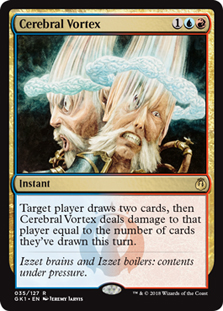
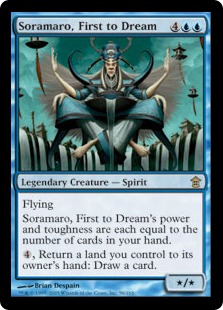
In (2):
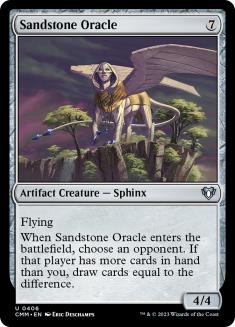
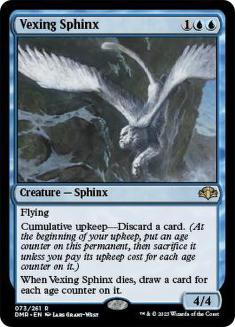
So, to start I cut Cerebral Vortex and Soramaro, First to dream. There are some excellent card-drawing Sphinxes out there, chief among them being Consecrated Sphinx, so it seems odd to go outside of the tribe in a deck like this one. I refrained from adding in Consecrated Sphinx due to its polarizing reputation, but if your group isn’t going to insta-kill it and you, it’s definitely a card to consider.
Vexing Sphinx isn’t the most powerful card, and having to discard cards to it is an annoying upkeep cost, but with a commander like Arjun, the Shifting Flame, and backed by the draw power of another one of your engines, what the card can do is help you dig the chaff out of your library while you’re stacking the bottom. Plus, it’s a three-drop Sphinx. That seems decent in a deck like this!
Then there’s Sanstone Oracle. While I’m not the biggest fan of this card, I like that it is a Sphinx, is a colorless artifact (allowing it to see a lot of play down the line), and that it’s tied to a body with evasion and sufficient power and toughness to be a threat. It’s not the best Sphinx, but it’s not a bad one!
Defensive Maneuvers
Out (1):
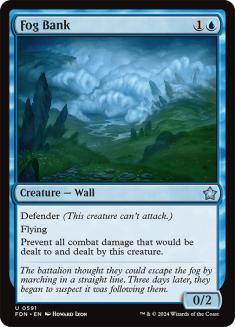
In (1):
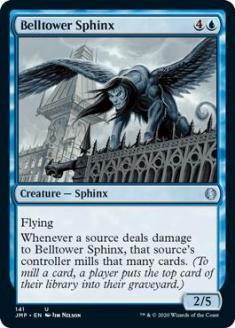
In general, I have been underwhelmed by Fog Bank in Commander. While it does a good job of shutting down a creature without trample, it does not provide a disincentive to attack you. In fact, some people are going to see it as a reason to attack you with more creatures, since they’re assured not to lose whatever the Fog Bank blocks. This might be worth it, but that inability to handle trample really does end up being a deal breaker far too often.
Instead, let’s bring in another Sphinx, this one from the Draft pile. Belltower Sphinx is a surprisingly decent body for Commander. It’s a five-drop Sphinx, which helps you set up your sky-borne defenses in time to stem the first typical wave of sustained aerial aggro. It has evasion, which helps it swing in when needed. And the rattler ability, a mill, fits with the potential victory condition offered by Sphinx’s Tutelage. It’s not an amazing card, but it’s solid and on theme, and that’s often the best we can do.
Remove Obstacles
Out (4):
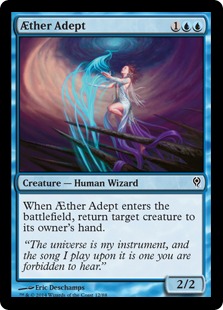
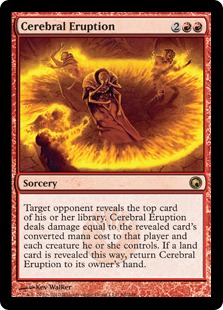
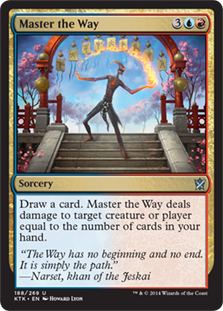
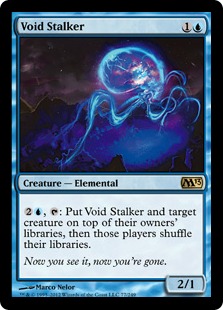
In (3):
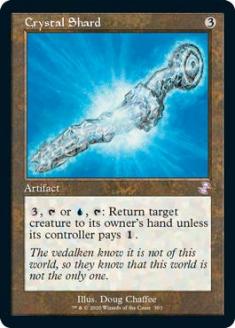
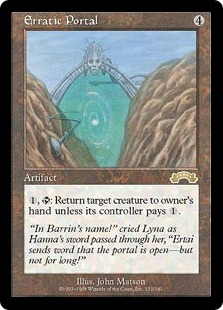
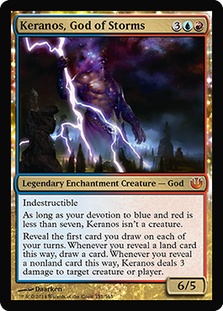
I cut these cards primarily for power level reasons. Aether Adept is decent in a flickermancer-style deck, or some other context in which the body will continue to be relevant after the effect is first cashed in, but this doesn’t really seem to be that deck. Cerebral Eruption is a card that’s at a high risk to fail you when you need it the most. Sure, sometimes you’ll mise the right card off the top of an opponent’s library, but all too often you’ll either miss, forcing you to spend even more mana on the effect, or hit an insufficiently large spell. If you could stack their library, that would be one thing, but I don’t think this deck has a lot of ways to do that. Maybe if there was a Lantern of Insight in the deck, instead of just Telepathy, but knowing what’s in an opponent’s hand doesn’t make Cerebral Eruption any less variable.
Master the Way is just a weak removal spell. Compare it to Keranos, God of Storms, an addition that seemed fitting given the knowledge theme and the initial plan to use him as your commander. They have the same mana cost, and Master the Way is a tad faster, but Keranos draws you more cards over time and can animate to smack your opponent in the face. This is particularly true with all the scry, letting you set up an extra draw or a Lightning Bolt… whatever you need that moment. A one-shot card draw spell like Master the Way is far less useful, particularly when the card you draw is subject to being Mindmoiled away by Arjun.
The final two additions in this section are more like pseudo-removal than the real deal. Much of the time, Crystal Shard and Erratic Portal just mean your opponent needs to leave up at least one mana or potentially lose two of their creatures over a turn cycle. Occasionally you’ll nug someone who needs to tap out, but it’s definitely a secondary factor. For these two wonderful cards (which I seriously advise people to get some experience playing), their true value is in being able to save your creatures in response to removal, or to reset Mulldrifters. They’re powerful little role-players, and I think they’d fit this deck well… especially if you need to dig for something, and have some extra creatures on board that you can bounce back to see even more of your deck with Arjun.
Faff About
Out (1):
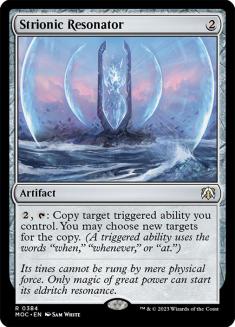
In (1):

This section heading probably comes off a bit dismissively, but it is not meant as such. I enjoy screwing around in games of Commander, doing things because they’re entertaining, not necessarily because they get me closer to an endgame goal. Cards like Strionic Resonator can let me do that, since copying a triggered ability is not a bad way to spend two mana. But it’s a less powerful card than its activated analogue, Rings of Brighthearth, and while Arjun, the Shifting Flame does spawn out a triggered effect, it doesn’t double particularly well. Unless a deck is built around triggered abilities (like my Edric, Spymaster of Trest deck, for example), a card like this needs to synergize well with your commander to earn its slot, and this one doesn’t.
Instead, let’s maximize the power of your scry with another Sphinx, Arbiter of the Ideal. This is a sweet one, and it works exactly opposite how I initially thought it worked. Basically, when I first saw this card I saw inspired, the Born of the Gods printing, and the use of the word “enchantment” in the ability, and I assumed that this was some enchantment enabler. And, in a way, it is… it does let you spawn out more enchantments than you even had in your deck. But it’s not, it’s actually best without enchantments because enchantments (and planeswalkers) are the two permanent types it chokes on.
A Sphinx that synergizes with the scry theme, though, is exactly the type of tweak that’s worth stretching the deck to include.
Scrying Stones
Out (0):
In (2):
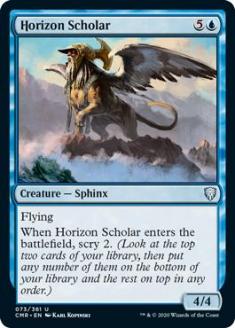
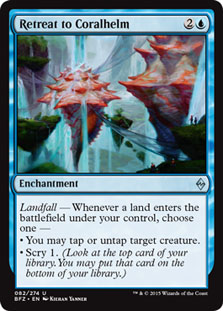
I like the scry subtheme. It’s very flavorful, and personally I just think it’s a useful thing to include in Commander decks. I’m very happy that they’ve evergreened the ability, and I look forward to getting some more interesting enablers down the line. Specifically, I want more cards like Knowledge and Power. One or two more of those effects and Commander decks will start to be able to rely on them, making them full-fledged “build around” cards. As is, leaning on scry is similar to building a tribal deck around Sphinxes: there’s not a ton of mechanical support, but that doesn’t make it bad.
Horizon Scholar seems like a slam dunk inclusion, since it offers a Sphinx body and a scry trigger upon entering the battlefield (which will combo nicely with the Crystal Shard/Erratic Portal engine added above). It’s an evasive threat that will probably take something else out before it dies, and that’s good for a role-player. Retreat to Coralhelm is similarly powerful. The scry landfall trigger is pretty sweet, especially since Arjun’s probably going to be hitting all its land drops, and the Twiddle effect offers a sweet combo with Arbiter of the Ideal, amongst other cards.
In the future, if you further modify the deck, I would suggest adding in the cantrips like Ponder and Preordain. Being able to ditch your hand to Arjun for one mana allows you to keep cycling until you find what you’re looking for, and the cast trigger means these cantrips will resolve after you’ve drawn up your new hand.
Counter Opposition
Out (2):
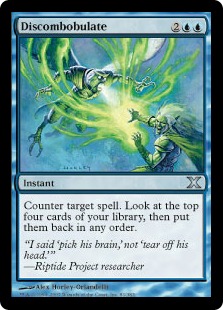

In (1):
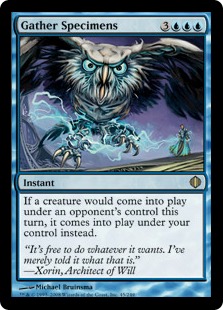
If I’m running a four-mana counterspell in Commander, it’s probably going to be Dismiss. My Cryptic Commands are ear-marked for Modern, but in most situations Dismiss does a fairly budget impersonation of the two modes most-commonly chosen for that spell. If Discombobulate was scry 4, I still think I’d prefer Dismiss, but in a deck like this it might be a reasonable inclusion, given the general theme. But being unable to bottom cards makes the Ponder effect on Discombobulate significantly weaker. If you’re getting those four cards anyway the next time you cast a spell, their order is almost irrelevant.
And yes, you may have times when your commander is not on the board, and the stack four cards ability is better in that scenario. But Commander is a format tied to commanders, and you don’t want cards in your hand keeping you from wanting to cast your commander. Particularly when your commander is a 5/5 flier for six mana.
Essence Backlash similarly compares poorly to some of the alternatives. Here, the alternative is Brutal Expulsion, and while there are reasons that you’d want the Backlash over the spell bounce, the decks most likely to prefer that are ones where direct damage to a player is incentivized by effects like Furnace of Rath. This just isn’t one of those decks.
But the deck’s running several other solid counterspells, including Spelljack. To that effect, I considered adding in Aethersnatch or Commandeer, but people tend to underestimate the potential brutality of Gather Specimens. Unlike most Essence Scatter and Remove Soul effects, Gather Specimens can “counter” anything that puts bodies on the field. This adds cards like Martial Coup and Warp World into the mix, as well as potentially stealing a Phyrexian Processor token or shutting down a lethal Splinter Twin or that irritating Thopter Assembly and Time Sieve combo. It’s surprisingly versatile and very hard to play around. And, if I have my Vorthos right, the guy on the flavor text is one of Sharuum the Hegemon’s people, giving you a way to have a link to the most famous legendary Sphinx of all time.
I’d also consider adding in Time Stop down the line, as another sphin-like Counterspell, but that’s another card I think gets less attention than it deserves.
The List
Creatures (34)
- 1 Belltower Sphinx
- 1 Cerulean Sphinx
- 1 Vexing Sphinx
- 1 Dreamscape Artist
- 1 Cryptic Annelid
- 1 Sharding Sphinx
- 1 Sphinx Ambassador
- 1 Sphinx of Jwar Isle
- 1 Sphinx of Lost Truths
- 1 Sea Gate Oracle
- 1 Sphinx of Magosi
- 1 Augury Owl
- 1 Conundrum Sphinx
- 1 Argent Sphinx
- 1 Psychosis Crawler
- 1 Chancellor of the Spires
- 1 Azure Mage
- 1 Sphinx of Uthuun
- 1 Windreader Sphinx
- 1 Thassa, God of the Sea
- 1 Omenspeaker
- 1 Prognostic Sphinx
- 1 Horizon Scholar
- 1 Arbiter of the Ideal
- 1 Stormcaller of Keranos
- 1 Sigiled Starfish
- 1 Keranos, God of Storms
- 1 Stormchaser Chimera
- 1 Chasm Skulker
- 1 Master of Predicaments
- 1 Alhammarret, High Arbiter
- 1 Guardian of Tazeem
- 1 Sandstone Oracle
- 1 Arjun, the Shifting Flame
Lands (38)
Spells (28)
- 1 Brainstorm
- 1 Soothsaying
- 1 Urza's Incubator
- 1 Sol Ring
- 1 Future Sight
- 1 Arcane Denial
- 1 Wayfarer's Bauble
- 1 Crystal Shard
- 1 Telepathy
- 1 Erratic Portal
- 1 Fact or Fiction
- 1 Spelljack
- 1 Izzet Signet
- 1 Foresee
- 1 Mystic Speculation
- 1 Riddle of Lightning
- 1 Dream Fracture
- 1 Gather Specimens
- 1 Armillary Sphere
- 1 Crystal Ball
- 1 Counterflux
- 1 Izzet Cluestone
- 1 Steam Augury
- 1 Interpret the Signs
- 1 Knowledge and Power
- 1 Commander's Sphere
- 1 Sphinx's Tutelage
- 1 Retreat to Coralhelm

The Cost
I have included a bunch of other potential options for cards, so this cost should be preliminary… but I kept it under $20. Given that this falls below the store credit which Jeff will receive for having his submission to Dear Azami chosen by us, that should leave him just enough money to entice him to purchase some other strong Commander cards. For example, this might be the type of deck worth playing Sensei’s Divining Top, as loathe as I am to suggest that.
Anyway, here’s the breakdown:
|
Card |
Cost |
|
0.25 |
|
|
0.25 |
|
|
0.49 |
|
|
0.49 |
|
|
0.49 |
|
|
0.89 |
|
|
0.99 |
|
|
0.99 |
|
|
1.55 |
|
|
11.69 |
|
|
Total |
18.08 |
Keranos, God of Storms seemed worth the relatively disproportionate price tag.
That’s it for this week’s Dear Azami; if you like this experiment with a shorter column (that is still at least 3.5x the average attention span of an internet reader), chime in the comments below. As usual, SUBMIT, and tune in next week for Levi’s take on another one of these secondary Commander 2015 legends.
Want to submit a deck for consideration to Dear Azami? We’re always accepting deck submissions to consider for use in a future article. Only one deck submission will be chosen per article, but being selected for the next edition of Dear Azami includes not just deck advice but also a $20 coupon to StarCityGames.com!
Email us a deck submission using this link here!
Like what you’ve seen? Feel free to explore more of Dear Azami here, in the Article Archives! And feel free to check Jess’s own Command of Etiquette column on Hipsters of the Coast, for more Commander and casual content. Now on Thursdays!

